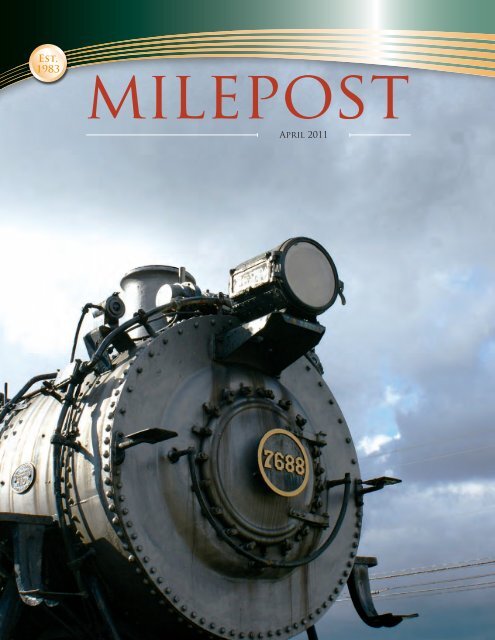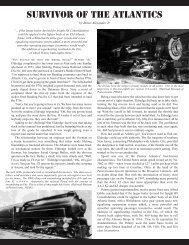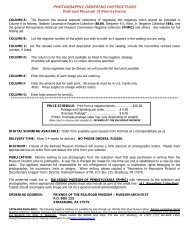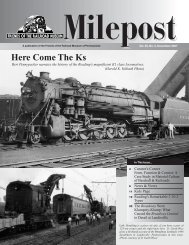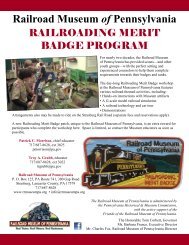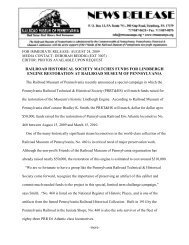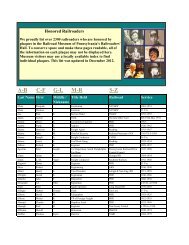21638 - April 2011 Milepost.indd - Railroad Museum of Pennsylvania
21638 - April 2011 Milepost.indd - Railroad Museum of Pennsylvania
21638 - April 2011 Milepost.indd - Railroad Museum of Pennsylvania
Create successful ePaper yourself
Turn your PDF publications into a flip-book with our unique Google optimized e-Paper software.
<strong>April</strong> <strong>2011</strong><br />
<strong>April</strong> <strong>2011</strong><br />
1
in this issue...<br />
3 Curator’s Corner:<br />
Accessibility and the<br />
railroad museum <strong>of</strong><br />
pennsylvania library<br />
and archives<br />
by Nicholas Zmijewski and<br />
Bradley K. Smith<br />
10 Spawning the<br />
Conservation<br />
Movement: The<br />
<strong>Railroad</strong> Fish Car<br />
by Troy Grubb<br />
14 Remembering the<br />
Wellsville, Addison &<br />
Galeton<br />
by Jeremy F. Plant<br />
20 News & Views<br />
Cover Photo: <strong>Pennsylvania</strong> <strong>Railroad</strong><br />
H10s steam freight locomotive No. 7688,<br />
built in 1915 by the Lima Locomotive<br />
Works, rests under a stormy sky at the<br />
<strong>Railroad</strong> <strong>Museum</strong> <strong>of</strong> <strong>Pennsylvania</strong>.<br />
(Ryan C. Kunkle Photo, courtesy <strong>of</strong> the<br />
photographer)<br />
Back Cover Photo: Shrouded in<br />
morning mist: the <strong>Railroad</strong> <strong>Museum</strong> <strong>of</strong><br />
<strong>Pennsylvania</strong>’s massive Nickel Plate<br />
Berkshire S-2 steam locomotive No. 757,<br />
built by the Lima Locomotive Works in<br />
1944. (Ryan C. Kunkle Photo, courtesy<br />
<strong>of</strong> the photographer)<br />
Vol. 29, No. 1, <strong>April</strong> <strong>2011</strong><br />
<strong>Pennsylvania</strong> Historical<br />
& <strong>Museum</strong> Commission<br />
Governor ...........................The Honorable<br />
Tom Corbett<br />
Chairman ..........................Mr. Wayne Spilove<br />
Executive Director............Ms. Barbara Franco<br />
<strong>Museum</strong> Director .............Mr. Charles Fox<br />
Members ...........................Ms. Flora Becker<br />
Ms. Rhonda R. Cohen Sen. Jim Ferlo<br />
Ms. Laura S. Fisher Ms. Cheryl McClenney-Brooker<br />
Mrs. Janet S. Klein Mr. Robert Matzie<br />
Ms. Kathleen Pavelko Rep. Scott Petri<br />
Sen. Joseph B. Scarnati Ms. Michele Sellitto<br />
Mr. Ronald J. Tomalis Ms. Mary Clare Zales<br />
The <strong>Railroad</strong> <strong>Museum</strong> <strong>of</strong> <strong>Pennsylvania</strong> is administered<br />
by the <strong>Pennsylvania</strong> Historical & <strong>Museum</strong> Commission<br />
with the active support <strong>of</strong> the Friends <strong>of</strong> the <strong>Railroad</strong><br />
<strong>Museum</strong> <strong>of</strong> <strong>Pennsylvania</strong>.<br />
Friends <strong>of</strong> the<br />
<strong>Railroad</strong> <strong>Museum</strong> <strong>of</strong> <strong>Pennsylvania</strong><br />
Board <strong>of</strong> Directors<br />
President ...........................Mr. George Higgins<br />
Vice President ...................Mr. James R. Rose<br />
Secretary ...........................Mr. Grant S. Markley<br />
Treasurer ...........................Mr. Joel E. Long<br />
Members ...........................Mr. Albert Giannantonio<br />
Mr. Craig Haberle Mr. Kent Haberle<br />
Mr. Frederick R. Merck Mrs. Margaret S. Poore<br />
Mr. Philip O. Ritter Mr. Emery Simkulak<br />
Mr. Frank Tatnall Mr. David Wood<br />
Ex Officio ..........................Mr. Charles Fox<br />
The Friends <strong>of</strong> the <strong>Railroad</strong> <strong>Museum</strong> <strong>of</strong> <strong>Pennsylvania</strong><br />
(FRM) is a non-pr<strong>of</strong>it volunteer museum support<br />
organization chartered by the <strong>Pennsylvania</strong> Historical<br />
& <strong>Museum</strong> Commission. Mailing Address:<br />
Friends <strong>of</strong> the <strong>Railroad</strong> <strong>Museum</strong> <strong>of</strong> <strong>Pennsylvania</strong><br />
P. O. Box 125<br />
Strasburg, PA 17579<br />
www.rrmuseumpa.org<br />
<strong>Railroad</strong> <strong>Museum</strong> <strong>of</strong> <strong>Pennsylvania</strong><br />
Advisory Council<br />
President ...........................Mr. Ronald Bailey<br />
Secretary ...........................Ms. Deborah Reddig<br />
Members ...........................Mr. Christopher S. Barrett<br />
Mr. William V. Hecker Mr. Edward S. Hoover<br />
Mr. Rudy Husband Mrs. Donna L. Kreiser<br />
Mr. Bennett Levin Mr. Jeffrey J. Majersky<br />
Mr. Linn Moedinger Ms. Harriet Parcells<br />
Mr. Paul Quinn Mr. Douglas Watts<br />
Honorary<br />
Dr. Jeremy F. Plant Mr. Bill Schafer<br />
Mr. William Withuhn<br />
Supporting<br />
Mr. James Alexander Jr Mr. Edward B. Betz<br />
Dr. John H. Bowman Mr. Robert R. Donecker<br />
Mr. Charles Fox Mr. Robert J. Lawrence<br />
Mr. Jere W. Schuler<br />
<strong>Milepost</strong><br />
Managing Editor .......Deborah Reddig<br />
Contributing Editors ....William R. Rowland<br />
James Alexander Jr<br />
Charles Fox<br />
Photo/Technical Editors Ryan C. Kunkle<br />
Nicholas Zmijewski<br />
Design/Layout..........Heather Shaubach,<br />
Cooper Printing, Inc.<br />
Deborah Reddig<br />
Printed by Cooper Printing, Inc., Lancaster, PA<br />
<strong>Milepost</strong> is published by and for the Friends <strong>of</strong> the<br />
<strong>Railroad</strong> <strong>Museum</strong> <strong>of</strong> <strong>Pennsylvania</strong> five times a year at<br />
Strasburg, PA 17579. Subscription to the <strong>Milepost</strong> is<br />
included as part <strong>of</strong> annual membership in the FRM.<br />
Mailed at Second-Class Postage rates at Strasburg, PA.<br />
Postmaster: Please send change <strong>of</strong> address to:<br />
P. O. Box 125, Strasburg, PA 17579<br />
Phone: (717) 687-8628 • Fax: (717) 687-0876<br />
Email: info@rrmuseumpa.org
Photo at Right: By<br />
creating the archives annex<br />
in 2000, the <strong>Museum</strong> more<br />
than doubled the space<br />
available to accommodate<br />
library and archival<br />
materials. This space<br />
originally served as the<br />
<strong>Museum</strong>’s wood shop.<br />
(Bradley K. Smith Photo,<br />
<strong>Railroad</strong> <strong>Museum</strong> <strong>of</strong><br />
<strong>Pennsylvania</strong>, PHMC)<br />
Photo Below: The <strong>Museum</strong>’s Union<br />
Switch & Signal Collection includes<br />
over 2,000 images depicting all<br />
aspects <strong>of</strong> that company’s operations.<br />
This photograph shows a woman<br />
working at the company’s Swissvale<br />
plant during World War II. (RR78.10,<br />
MG199, <strong>Railroad</strong> <strong>Museum</strong> <strong>of</strong><br />
<strong>Pennsylvania</strong>, PHMC)<br />
Curator’s Corner<br />
ACCESSIBILITY AND THE RAILROAD<br />
MUSEUM OF PENNSYLVANIA<br />
LIBRARY AND ARCHIVES<br />
by Nicholas Zmijewski and Bradley K. Smith<br />
In addItIon to a world-class collectIon oF More tHan 100 HIstorIc<br />
locomotives and railroad cars and a collection <strong>of</strong> over 12,000 smaller artifacts,<br />
the <strong>Railroad</strong> <strong>Museum</strong> <strong>of</strong> <strong>Pennsylvania</strong> cares for one <strong>of</strong> the largest and most<br />
important library and archival collections <strong>of</strong> railroad history in the United<br />
States. While the library and archives have been nearly a half-century in the<br />
making, it is only within the last several years that the <strong>Museum</strong> has begun to<br />
fully utilize the collection for the benefi t <strong>of</strong> the public.<br />
Origins And Growth Of The Library And Archives<br />
In 1963, the <strong>Pennsylvania</strong> state legislature authorized the creation <strong>of</strong> a state<br />
railroad museum and, on February 18, 1965, the <strong>Pennsylvania</strong> Historical &<br />
<strong>Museum</strong> Commission selected Strasburg as the site for this museum. Almost<br />
immediately thereafter, agents <strong>of</strong> the Commission began collecting books and<br />
documents in anticipation <strong>of</strong> the yet-to-be-built <strong>Museum</strong>. 1 Since construction<br />
<strong>of</strong> a <strong>Museum</strong> building would not commence until 1972, they temporarily<br />
accepted and held these early donations at the William Penn Memorial <strong>Museum</strong><br />
and the <strong>Pennsylvania</strong> State Archives in Harrisburg.<br />
The <strong>Museum</strong>’s fi rst director, George Hart, led a crucial initiative by<br />
purchasing more than $27,000 <strong>of</strong> ephemera and records at the Penn Central<br />
Auction on March 20-23, 1972. Held at 30th Street Station in Philadelphia<br />
and publicized as the largest auction <strong>of</strong> railroad memorabilia in history, the<br />
sale featured an incredible array <strong>of</strong> <strong>Pennsylvania</strong> <strong>Railroad</strong> materials which one<br />
<strong>April</strong> <strong>2011</strong><br />
3
witness described as “mind boggling” and “wonderful.” 2 Hart recalled the following details <strong>of</strong> the auction in an oral<br />
history interview:<br />
“They had, prior to [the actual auction], an inspection period by anyone, which lasted one week, from a<br />
Monday to a Friday. You could make an examination <strong>of</strong> the things that were there, in boxes and by lot<br />
numbers. I went through every box and looked at everything there was… It took me from Monday until<br />
Thursday to do that, and I reserved Friday, the last day, because as I went along I put items down that I<br />
thought we’d be interested in or should have… When bidding time came, I knew what I was doing. I was<br />
looking to see where the [other] bidders were, but there were about two hundred there and I could not pick<br />
out the individuals.” 3<br />
Current Friends <strong>of</strong> the <strong>Railroad</strong> <strong>Museum</strong> <strong>of</strong> <strong>Pennsylvania</strong> board member/volunteer Philip Ritter was also in attendance<br />
at the Penn Central Auction. He recalls the following:<br />
“[George Hart] had two assistants and no one really knew who they were. They seemed to be well<br />
organized and knew what they wanted. [They were] snapping stuff up one after the other. People sort <strong>of</strong><br />
assumed they were dealers buying to re-sell. As the auction went on, it became obvious that the ‘ordinary<br />
collector’ was being left behind, and it looked like valuable historical material was being dispersed. When<br />
the auction was over, [auctioneer] Bo Freeman announced that the fellow who was doing all this buying<br />
represented the new <strong>Railroad</strong> <strong>Museum</strong>. There was just a moment’s pause, and then everyone clapped.” 4<br />
The Penn Central acquisition,<br />
consisting <strong>of</strong> 248 auction lots, put the<br />
yet-to-be-constructed <strong>Museum</strong> on the<br />
proverbial map, and highlights the<br />
fact that the <strong>Pennsylvania</strong> Historical<br />
& <strong>Museum</strong> Commission chose an<br />
opportune time to begin a railroad<br />
museum. 5 In the years between 1965,<br />
when the <strong>Museum</strong> collected its first<br />
archival materials, and 1976, the first<br />
full year the <strong>Museum</strong> was open to the<br />
public, nearly all <strong>of</strong> <strong>Pennsylvania</strong>’s<br />
major railroads went defunct, and<br />
new entities—most notably Amtrak<br />
and Conrail—emerged. Many<br />
railroaders that became employees<br />
<strong>of</strong> these new corporations hoped to<br />
4 <strong>April</strong> December <strong>2011</strong> 2010<br />
donate items in an effort to preserve<br />
the legacy <strong>of</strong> their former employers.<br />
At the same time, renowned railroad<br />
historians like Walter Lucas, Munson<br />
Paddock, Thomas Townsend Taber,<br />
Clinton Andrews and Howard Hill<br />
were downsizing their impressive<br />
private collections. The result <strong>of</strong><br />
this transition was an unequalled<br />
opportunity to acquire significant<br />
railroad artifacts and archival<br />
materials.<br />
Following his success at the Penn<br />
Central Auction, George Hart used<br />
his personal connections to pursue<br />
and acquire dozens <strong>of</strong> additional<br />
collections, both by donation and<br />
purchase, which he hoped to gather<br />
into an important railroad archive <strong>of</strong><br />
manuscripts, corporate records and<br />
ephemera. He described his vision as<br />
“all working together to bring together<br />
this collection <strong>of</strong> collections”. 6<br />
Because <strong>of</strong> these efforts, the <strong>Railroad</strong><br />
<strong>Museum</strong> <strong>of</strong> <strong>Pennsylvania</strong> evolved<br />
into one <strong>of</strong> the largest archival<br />
repositories <strong>of</strong> any Commission field<br />
site, and one <strong>of</strong> the most significant<br />
railroad archives in the United States.<br />
The <strong>Museum</strong> archives now consists<br />
<strong>of</strong> approximately 3,500 cubic feet<br />
<strong>of</strong> corporate records, photographs,<br />
negatives, manuscripts, maps, blue<br />
prints, tracings, trade journals,<br />
books, periodicals, ephemera, motion<br />
picture films and audio recordings.<br />
Particularly impressive collections<br />
<strong>of</strong> corporate records include the<br />
following:<br />
• Mechanical engineering drawings<br />
and surviving company records<br />
Photo at Left: While perhaps better<br />
known for our large collections <strong>of</strong><br />
photographs and drawings, the <strong>Railroad</strong><br />
<strong>Museum</strong> also cares for an equally<br />
impressive collection <strong>of</strong> paper<br />
ephemera items, including this 1950s<br />
brochure advertising the infamous EMD<br />
Aerotrain. (RR86.9, MG199, <strong>Railroad</strong><br />
<strong>Museum</strong> <strong>of</strong> <strong>Pennsylvania</strong>, PHMC)
from the Wilkes-Barre-based<br />
Vulcan Locomotive Works, one <strong>of</strong><br />
the nation’s leading manufacturers<br />
<strong>of</strong> industrial locomotives, 1870-<br />
1950 (100 cubic feet).<br />
• Records <strong>of</strong> the Lehigh & Hudson<br />
River <strong>Railroad</strong>, 1880-1980 (80<br />
cubic feet); the Upper Merion &<br />
Plymouth <strong>Railroad</strong>, 1950-70 (25<br />
cubic feet); and segments <strong>of</strong> the<br />
Pittsburgh & Lake Erie Railway (60<br />
cubic feet); the Reading Company<br />
(20 cubic feet); the Maryland &<br />
<strong>Pennsylvania</strong> <strong>Railroad</strong>, ca. 1880-<br />
1979 (50 cubic feet) and the<br />
Buffalo & Susquehanna <strong>Railroad</strong>,<br />
1894-1931 (114 cubic feet)<br />
• A major segment <strong>of</strong> the<br />
<strong>Pennsylvania</strong> <strong>Railroad</strong> Company’s<br />
original library.<br />
• Various historical records in<br />
smaller quantities representing<br />
over 1,200 different rail lines and<br />
related manufacturers.<br />
<strong>Museum</strong> archival holdings also<br />
include more than a half million<br />
historic railroading images preserved<br />
in the form <strong>of</strong> glass plate negatives,<br />
cellulose nitrate fi lm, safety fi lm,<br />
transparency fi lm and photographic<br />
prints. These images depict railroad<br />
labor, travelers, steam and diesel<br />
locomotives, rolling stock, depots,<br />
yards, bridges, engine houses and<br />
right-<strong>of</strong>-way views, dating from the<br />
1850s to the present. Some <strong>of</strong> the<br />
most impressive collections include<br />
the following:<br />
• The Herbert L. Broadbelt<br />
Collection consists <strong>of</strong> 18,000<br />
glass plate and fi lm negatives<br />
documenting production from<br />
1871 to 1954 at the Baldwin<br />
Locomotive Works, the nation’s<br />
leading locomotive manufacturer<br />
with a global clientele.<br />
• The Budd Company Collection<br />
features approximately 13,000<br />
images highlighting the activities<br />
<strong>of</strong> this important <strong>Pennsylvania</strong><br />
manufacturer from the 1940s<br />
through the 1960s, including a<br />
number <strong>of</strong> early, large format color<br />
images.<br />
• The Union Switch & Signal<br />
Collection contains over 2,000<br />
images documenting signals,<br />
centralized traffi c control, the<br />
installation <strong>of</strong> hump yards and<br />
railroad radio experiments.<br />
• The Benjamin F. G. Kline<br />
Jr Collection contains more<br />
than 6,000 views <strong>of</strong> short line,<br />
industrial and lumbering railroads<br />
in <strong>Pennsylvania</strong>.<br />
The drawback <strong>of</strong> being <strong>of</strong>fered so<br />
many excellent collections was that<br />
the <strong>Railroad</strong> <strong>Museum</strong> <strong>of</strong> <strong>Pennsylvania</strong><br />
<strong>of</strong> the late 1970s and early 1980s<br />
was inundated and overwhelmed by<br />
archival materials. Despite important<br />
contributions made by early<br />
volunteers such as Richard Hain and<br />
Thomas T. Taber III, staff members<br />
<strong>of</strong> this era struggled to process<br />
incoming acquisitions. Furthermore,<br />
the <strong>Museum</strong> lacked adequate storage<br />
space to accommodate such a large<br />
and growing collection.<br />
Fortunately, the <strong>Pennsylvania</strong><br />
Historical & <strong>Museum</strong> Commission<br />
began devoting more staff resources<br />
toward managing the <strong>Railroad</strong><br />
<strong>Museum</strong>’s collections and, in fact,<br />
Commission archivists processed<br />
554 cubic feet <strong>of</strong> <strong>Museum</strong> archival<br />
material between 1983 and 1985.<br />
After their incorporation in 1983,<br />
the Friends <strong>of</strong> the <strong>Railroad</strong> <strong>Museum</strong><br />
<strong>of</strong> <strong>Pennsylvania</strong> also began making<br />
signifi cant volunteer and paid staff<br />
contributions to the processing <strong>of</strong><br />
archival material. In addition, staff<br />
remedied the storage space shortage in<br />
2000 when they transferred the wood<br />
shop from the basement <strong>of</strong> the main<br />
building to the restoration shop, and<br />
then obtained the funding to install<br />
high-density compact shelving in the<br />
vacated space to create the <strong>Museum</strong>’s<br />
“archives annex.”<br />
Making The Library And<br />
Archives Accessible<br />
The American Association <strong>of</strong><br />
<strong>Museum</strong>s (AAM) document, A<br />
Higher Standard, details the standards<br />
<strong>of</strong> a pr<strong>of</strong>essionally administered<br />
<strong>Museum</strong> and among them lists that a<br />
pr<strong>of</strong>essional museum “demonstrates<br />
a commitment to providing the public<br />
Photo above: Friends <strong>of</strong> the <strong>Railroad</strong><br />
<strong>Museum</strong> <strong>of</strong> <strong>Pennsylvania</strong> volunteers Bob<br />
Lawrence and Loretta Harrison, and others,<br />
have contributed countless hours toward<br />
cataloguing library and archival material<br />
in LADRS. In the background to the right<br />
are thousands <strong>of</strong> photographic prints<br />
representing <strong>Pennsylvania</strong>’s many<br />
railroads and related industries. (Bradley<br />
K. Smith Photo, <strong>Railroad</strong> <strong>Museum</strong> <strong>of</strong><br />
<strong>Pennsylvania</strong>, PHMC)<br />
<strong>April</strong> <strong>2011</strong><br />
5
with physical and intellectual access<br />
to the museum and its resources.” 7<br />
with physical and intellectual access<br />
With this standard in mind, the<br />
<strong>Railroad</strong> <strong>Museum</strong> <strong>of</strong> <strong>Pennsylvania</strong><br />
has always striven to make its<br />
collections accessible to anyone<br />
interested. The process <strong>of</strong> making<br />
collections accessible begins by<br />
establishing intellectual and physical<br />
control—simply put, determining<br />
where each collection came from,<br />
what each entails and where each is<br />
located within the <strong>Museum</strong>—and then<br />
developing paper or computerized<br />
fi nding aids that can point users to<br />
these collections.<br />
The <strong>Museum</strong>’s efforts to make<br />
archival collections accessible began<br />
in 1986 when volunteers started<br />
building databases for archival<br />
collections using an Apple IIe<br />
computer. In the interest <strong>of</strong> building<br />
upon this work, the Friends <strong>of</strong> the<br />
6 <strong>April</strong> <strong>2011</strong><br />
<strong>Railroad</strong> <strong>Museum</strong> <strong>of</strong> <strong>Pennsylvania</strong><br />
began converting large batches <strong>of</strong> this<br />
data to PC format in 1997. It was also<br />
at this time that the Commission and<br />
the Friends began to formulate plans<br />
for a more comprehensive archives<br />
database which they would call<br />
“LADRS,” the Library And Archives<br />
Data Retrieval System.<br />
LADRS was a creation <strong>of</strong> several<br />
individuals including former <strong>Museum</strong><br />
director David Dunn and FRM<br />
volunteers Jim Alexander, George<br />
Burbage, Robert Donecker and the<br />
late Earle Compton. They recognized<br />
that the <strong>Museum</strong> needed more than<br />
simple fi nding aids. It required a<br />
more complex management system<br />
that would meet the needs <strong>of</strong> both<br />
the using public—with a special<br />
understanding <strong>of</strong> railroad history<br />
and nomenclature—and <strong>of</strong> the<br />
institutional standards <strong>of</strong> modern<br />
museums. Fortunately, critical<br />
skill sets came together as staff and<br />
volunteers contributed to the general<br />
management and planning, while<br />
applying their collective knowledge<br />
<strong>of</strong> computer technology and historical<br />
documentation standards.<br />
After reviewing several commercial<br />
systems, the <strong>Museum</strong> decided to build<br />
LADRS using a database application<br />
called Inmagic DB Textworks,<br />
which staff and volunteers initially<br />
populated with pre-existing data from<br />
older databases. The completion <strong>of</strong><br />
LADRS gave the <strong>Railroad</strong> <strong>Museum</strong><br />
<strong>of</strong> <strong>Pennsylvania</strong> an excellent tool for<br />
establishing intellectual and physical<br />
control over its archival collection,<br />
and a successful model for presenting<br />
this information to users, but the<br />
PHMC/FRM partnership continued<br />
to recognize the need for growth and<br />
enhanced public access.<br />
The North American Railway<br />
Foundation provided several years<br />
<strong>of</strong> critical funding that augmented<br />
the Friends’ efforts to underwrite the<br />
computer infrastructure necessary to<br />
support LADRS. With their support,<br />
the <strong>Museum</strong> acquired new hardware,<br />
s<strong>of</strong>tware and the temporary staff<br />
assistance needed to scan images<br />
and documents. By capturing highresolution<br />
electronic images <strong>of</strong> paper<br />
and fi lm items, the <strong>Museum</strong> has<br />
reduced the need to handle delicate<br />
original items while providing<br />
thumbnail images which are easily<br />
accessible to researchers through<br />
LADRS.<br />
While initial search capabilities<br />
into this database were only available<br />
internally, the <strong>Museum</strong> partnered with<br />
Andornot Information Management<br />
Solutions to make the data in LADRS<br />
Photo above: Pictured here is a poster<br />
advertising the Penn Central Auction <strong>of</strong><br />
1972. By purchasing 248 lots at this<br />
auction, the <strong>Railroad</strong> <strong>Museum</strong> <strong>of</strong><br />
<strong>Pennsylvania</strong>’s founders acquired a<br />
strong foundation upon which the library<br />
and archives could grow. (RR2008.5.2,<br />
<strong>Railroad</strong> <strong>Museum</strong> <strong>of</strong> <strong>Pennsylvania</strong>, PHMC)
available to on line researchers who<br />
can now browse the database from<br />
the comfort <strong>of</strong> their own home.<br />
The <strong>Museum</strong> uploads new data to<br />
the host site twice per year, and the<br />
Friends <strong>of</strong> the <strong>Railroad</strong> <strong>Museum</strong> <strong>of</strong><br />
<strong>Pennsylvania</strong> pays the annual hosting<br />
fees <strong>of</strong> $5,000 while also funding and<br />
managing the operations <strong>of</strong> the local<br />
computer network.<br />
As FRM technology manager Jim<br />
Alexander noted, “We had to look<br />
very hard to fi nd a computer system<br />
that could meet both internal and user<br />
needs, have the ability to grow, meet<br />
pr<strong>of</strong>essional archives management<br />
standards and be affordable.<br />
Inmagic’s programs turned out to<br />
be an ideal choice but, what made<br />
it really feasible was, the ability <strong>of</strong><br />
the Andornot team to listen to the<br />
practical needs <strong>of</strong> railroad researchers<br />
to make this a responsive, properly<br />
tuned tool.” 8<br />
The Friends <strong>of</strong> the <strong>Railroad</strong><br />
<strong>Museum</strong> <strong>of</strong> <strong>Pennsylvania</strong> has<br />
contributed tens <strong>of</strong> thousands <strong>of</strong><br />
volunteer hours toward the LADRS<br />
endeavor since 1997. As <strong>of</strong> March 1,<br />
<strong>2011</strong>, the LADRS catalogue contained<br />
154,825 archival catalogue records<br />
and 6,973 library catalogue records,<br />
with these numbers increasing every<br />
week. LADRS currently contains<br />
25,052 thumbnail images accessible<br />
to the public.<br />
During the process <strong>of</strong> cataloguing<br />
collections into LADRS, staff and<br />
volunteers are fi nding duplication<br />
<strong>of</strong> documents, ephemera and books.<br />
Not having had full inventories in the<br />
past, it was impossible for any one<br />
individual to know the collection well<br />
enough to prevent duplicate items<br />
from fi ltering in. Staff members<br />
Photo above: This letter, written by<br />
Andrew Carnegie in 1865, is one <strong>of</strong> the<br />
many signifi cant documents preserved in the<br />
<strong>Museum</strong>’s archives. While Carnegie is best<br />
known as a successful steel tycoon, he wrote<br />
this letter while he was employed by the<br />
<strong>Pennsylvania</strong> <strong>Railroad</strong>. (RR98.36, MG199,<br />
<strong>Railroad</strong> <strong>Museum</strong> <strong>of</strong> <strong>Pennsylvania</strong>, PHMC)<br />
now check every potential donation<br />
against LADRS in an effort to<br />
avoid unnecessary duplicate copies<br />
from slipping into our holdings.<br />
Duplicates that are found are being<br />
removed from the collection, <strong>of</strong>fered<br />
to other museums and, if no suitable<br />
home can be found, sold through a<br />
special deaccession auction. This<br />
sale raises funds to help preserve<br />
existing collections or purchase new<br />
collections. Due to the premium on<br />
space at the <strong>Museum</strong>, this is both a<br />
necessary and benefi cial process.<br />
Norfolk Southern Foundation<br />
Grant<br />
Despite the success in bringing the<br />
<strong>Museum</strong>’s archival collections to the<br />
public, the capacity <strong>of</strong> LADRS and our<br />
library and archives had been limited<br />
by the shortcomings <strong>of</strong> the present<br />
<strong>April</strong> <strong>2011</strong><br />
7
infrastructure. For example, the<br />
<strong>Museum</strong>’s corps <strong>of</strong> dedicated library<br />
and archives volunteers had not been<br />
able to expand due to a shortage <strong>of</strong><br />
workstations. Furthermore, many <strong>of</strong><br />
the <strong>Museum</strong>’s archival collections<br />
are located in the archives annex,<br />
where there were no workstations.<br />
Consequently, cataloguing these<br />
collections required shuffl ing<br />
collections around the building, or<br />
cataloguing on paper sheets that<br />
volunteers subsequently entered into<br />
LADRS. Neither was ideal, for both<br />
methods are labor intensive and can<br />
lead to errors.<br />
With this in mind, the <strong>Museum</strong><br />
sought funding from the Norfolk<br />
Southern Foundation to implement<br />
the Library & Archives Enhancement<br />
Project. The <strong>Museum</strong> was pleased<br />
to announce recently that Norfolk<br />
Southern Foundation has funded<br />
this request, committing $60,000<br />
to implement infrastructure<br />
enhancements that will help make<br />
a substantially larger amount <strong>of</strong><br />
archival material available for public<br />
access.<br />
Infrastructure improvements<br />
include a larger capacity storage<br />
server to accommodate the increasing<br />
data loads generated by a growing<br />
database. The <strong>Museum</strong> expanded<br />
the current network’s capabilities by<br />
installing a new fi ber optic network<br />
backbone throughout the building,<br />
and installing four new network<br />
connections in the archives annex. The<br />
<strong>Museum</strong> has also acquired s<strong>of</strong>tware<br />
to maximize the effi ciency <strong>of</strong> the<br />
network and workstations, including<br />
enhanced antivirus programs, a new<br />
system for backing-up and protecting<br />
data and other related s<strong>of</strong>tware<br />
required for daily operations.<br />
Photo above: The <strong>Railroad</strong> <strong>Museum</strong> <strong>of</strong><br />
<strong>Pennsylvania</strong> collection includes dozens <strong>of</strong><br />
pr<strong>of</strong>essional and historic fi lms. This image<br />
is from amateur 16mm footage shot <strong>of</strong> New<br />
York’s Penn Station in 1959. (RR77.56,<br />
MG199, <strong>Railroad</strong> <strong>Museum</strong> <strong>of</strong> <strong>Pennsylvania</strong>,<br />
PHMC)<br />
8 <strong>April</strong> <strong>2011</strong><br />
The <strong>Museum</strong> will also increase<br />
the accessibility <strong>of</strong> its collections by<br />
purchasing a variety <strong>of</strong> additional<br />
tools. The acquisition <strong>of</strong> a micr<strong>of</strong>i lm<br />
reader will enable researchers, both on<br />
site and <strong>of</strong>f site via mail and email, to<br />
make use <strong>of</strong> the <strong>Museum</strong>’s collection<br />
<strong>of</strong> micr<strong>of</strong>i che and approximately<br />
150 rolls <strong>of</strong> micr<strong>of</strong>i lmed documents.<br />
This will also enable the <strong>Museum</strong> to<br />
pursue additional micr<strong>of</strong>i lm records<br />
that can be substituted in place<br />
<strong>of</strong> fragile original documents and<br />
periodicals. The <strong>Museum</strong> acquired a<br />
pr<strong>of</strong>essional quality scanner, capable<br />
<strong>of</strong> scanning negatives and slides,<br />
to increase the number <strong>of</strong> in-house<br />
scanning workstations from two<br />
to three. Finally, the <strong>Museum</strong> will<br />
purchase a book copier and scanner<br />
that will scan and copy historic books<br />
and other delicate bound materials<br />
safely and effi ciently.<br />
Services Offered<br />
As has been stated earlier, the<br />
<strong>Museum</strong> strives to make its worldclass<br />
collection as accessible as<br />
possible to any and all interested<br />
individuals. LADRS is one <strong>of</strong> the<br />
best tools available to individuals<br />
interested in the <strong>Museum</strong>’s library<br />
and archival collection. In the past<br />
year, researchers have used LADRS<br />
on more than 8,000 occasions.<br />
By using the LADRS database,<br />
researchers can review tens <strong>of</strong><br />
thousands <strong>of</strong> records, and access<br />
the information most relevant to<br />
them. For example, a researcher<br />
interested in the Willamsport &<br />
North Branch <strong>Railroad</strong> can use<br />
LADRS to immediately determine<br />
that the <strong>Museum</strong> collection includes<br />
at least 172 different archival items<br />
pertaining to that entity. LADRS<br />
will provide information to the<br />
researcher about each <strong>of</strong> these 172<br />
items, while showing staff members<br />
where each item is physically<br />
located. For a modest fee, staff can<br />
then produce high quality scans or<br />
prints <strong>of</strong> photographs, negatives,<br />
slides, drawings, maps, manuscripts<br />
or documents <strong>of</strong> particular interest.<br />
The <strong>Museum</strong> is also able to provide<br />
digital copies <strong>of</strong> historic motion<br />
pictures from the collection that<br />
were originally shot in 8mm, super 8,<br />
16mm or 35mm formats.<br />
Photo orders play a large role in the<br />
activities <strong>of</strong> the archives. As staff and<br />
volunteers scan items for a specifi c<br />
photo order or during the course <strong>of</strong><br />
regular cataloguing, they are placed<br />
on a storage server. By drawing from
images housed on this server, staff<br />
can complete image reproductions in<br />
a matter <strong>of</strong> minutes from the receipt<br />
<strong>of</strong> an order. Researchers are also able<br />
to see positives <strong>of</strong> the <strong>Museum</strong>’s<br />
negatives without the need to generate<br />
prints.<br />
Orders for images that are not<br />
already on the image server can take<br />
up to several weeks, depending on<br />
how many images need to be scanned<br />
and the availability <strong>of</strong> staff and<br />
equipment. The <strong>Museum</strong> nevertheless<br />
makes every effort to provide as<br />
prompt a service as is possible. Staff<br />
members utilize a specialized slide<br />
scanner that is equipped with an<br />
automatic feed to speed the scanning<br />
<strong>of</strong> 35mm transparencies, and three<br />
scanners that are capable <strong>of</strong> doing<br />
high resolution work with negatives.<br />
The <strong>Museum</strong> also partners with an<br />
outside company that is able to scan<br />
very large items including oversized<br />
photographs, maps and blueprints.<br />
The <strong>Museum</strong>’s reproduction standards<br />
are compatible with the needs <strong>of</strong> most<br />
publishers, and scans <strong>of</strong> <strong>Museum</strong><br />
images and drawings have been<br />
featured in numerous publications<br />
and books.<br />
Individuals who are able to<br />
travel can also utilize the collection<br />
by scheduling an appointment to<br />
visit the <strong>Museum</strong>’s research room.<br />
Patrons are required to schedule their<br />
appointments in advance, and they<br />
should consult the on line LADRS<br />
databases so that they can provide<br />
advance details <strong>of</strong> relevant material.<br />
This allows staff the time needed to<br />
pull material from the shelves prior to<br />
the visit.<br />
This on-site research program<br />
is quite popular. In the 2009/2010<br />
fi scal year, the <strong>Railroad</strong> <strong>Museum</strong><br />
<strong>of</strong> <strong>Pennsylvania</strong> accommodated 54<br />
researchers who each spent at least<br />
one day using the library and archives.<br />
The <strong>Museum</strong> has already exceeded<br />
that number in the current fi scal year,<br />
which ends on June 30.<br />
Staff and volunteers can perform<br />
research for patrons who cannot travel<br />
to the <strong>Museum</strong>. There is typically<br />
no fee for simple inquires, but the<br />
<strong>Museum</strong> does charge nominal fees<br />
for inquires that require more detailed<br />
research. In the most previous fi scal<br />
year, the <strong>Museum</strong> answered 443<br />
public research inquires.<br />
Despite the <strong>Museum</strong>’s success,<br />
the efforts to enhance accessibility<br />
are very much a work in progress.<br />
Current projects for volunteers in<br />
the archives include answering<br />
research queries, continued scanning<br />
<strong>of</strong> the General Negative Collection,<br />
fi nalizing the data entry on the<br />
John Harris Collection, data entry<br />
for the Jim Shuman and Richard<br />
Gladulich collections, scanning <strong>of</strong><br />
the remaining Baldwin Locomotive<br />
Works negatives, cataloguing library<br />
books and preparing collections in the<br />
annex for data entry by rehousing and<br />
identifying materials. Help is needed<br />
to make progress on a number <strong>of</strong><br />
these projects. However, prospective<br />
volunteers will have to wait for the<br />
arrival <strong>of</strong> the computers—expected<br />
by early summer—purchased with<br />
funds from the NS Foundation.<br />
While getting to this point has<br />
been a long, arduous process, the<br />
<strong>Museum</strong> believes it has an ethical<br />
responsibility to make its<br />
collections accessible, and<br />
it has been very satisfying<br />
to see the dream <strong>of</strong><br />
collections accessibility<br />
slowly become a reality.<br />
As <strong>Museum</strong> director<br />
Charles Fox observed,<br />
“LADRS represents a<br />
classic example <strong>of</strong> the success that<br />
has been achieved at the <strong>Museum</strong><br />
on so many fronts, based on this<br />
wonderful collaboration <strong>of</strong> Friends<br />
and <strong>Pennsylvania</strong> Historical &<br />
<strong>Museum</strong> Commission people<br />
and resources. In particular, the<br />
commitment and depth <strong>of</strong> expertise<br />
<strong>of</strong> the Friends over so many years has<br />
made a real difference. We now have<br />
a well-functioning system that meets<br />
many needs in a manner that meets<br />
high standards.” 9<br />
If you would like to learn more about<br />
our holdings or LADRS, please contact<br />
the <strong>Railroad</strong> <strong>Museum</strong> <strong>of</strong> <strong>Pennsylvania</strong><br />
or visit the <strong>Museum</strong>’s web site at http://<br />
www.rrmuseumpa.org.<br />
The authors thank Charles Fox,<br />
James Alexander Jr and Kurt Bell for<br />
their assistance with this article.<br />
Nicholas Zmijewski is archives<br />
technician and Bradley K. Smith is<br />
chief curator at the <strong>Railroad</strong> <strong>Museum</strong><br />
<strong>of</strong> <strong>Pennsylvania</strong>.<br />
NOTES<br />
1 For an overview <strong>of</strong> the <strong>Museum</strong>’s early<br />
history, see Kurt Bell, “A <strong>Railroad</strong> <strong>Museum</strong><br />
Retrospective, Part I,” <strong>Milepost</strong> 18:4<br />
(November, 2000): 11-21.<br />
2 Phil Ritter, interview by Brad Smith,<br />
Strasburg, PA, March 8, <strong>2011</strong>.<br />
3 Kurt R. Bell, ed., George Michener Hart:<br />
An Oral History (Strasburg: FRM/PHMC,<br />
February 1999), p. 28.<br />
4 Ritter. The two assistants were PHMC<br />
representatives Donald Kent and Bill<br />
Richards.<br />
5 Additional details <strong>of</strong> the Penn Central<br />
purchase can be found in the vital information<br />
fi le for that collection: RR72.1, MG199,<br />
<strong>Railroad</strong> <strong>Museum</strong> <strong>of</strong> <strong>Pennsylvania</strong>.<br />
6 Bell.<br />
7 One can view the American Association <strong>of</strong><br />
<strong>Museum</strong>’s document, A Higher Standard¸on<br />
the Association’s website at this link:<br />
http://www.aam-us.org/museumresources/<br />
accred/upload/Standards.pdf.<br />
8 James Alexander Jr, interview by Bradley K.<br />
Smith, Strasburg, PA, March 9, <strong>2011</strong>.<br />
9 Charles Fox, interview by Bradley K. Smith,<br />
Strasburg, PA, March 14, <strong>2011</strong>.<br />
Photo at Left: The <strong>Railroad</strong> <strong>Museum</strong> <strong>of</strong><br />
<strong>Pennsylvania</strong> cares for nearly a half million<br />
historic images such as this historic<br />
builder’s photo from the New Jersey<br />
Locomotive & Machine Company.<br />
(RR76.20, MG 199, <strong>Railroad</strong> <strong>Museum</strong><br />
<strong>of</strong> <strong>Pennsylvania</strong>, PHMC)<br />
<strong>April</strong> <strong>2011</strong><br />
9


